| Manufacturer: | Thrustline Aerospace |
Well, I've been drawn to a number of Thrustline kits, so add the A-SLAM to my growing list. Why did I select this rocket? I liked the multiple fins and the fact that it is a cluster of three (3) 18mm motors. Not to many cluster kits out there, so I was glad to get this one with their Smoke and Fire kit (three 24mm cluster; to be reviewed soon).
Another thing that makes the A-SLAM interesting, to me, is that it is a 2.27" diameter kit. I do not believe I have ever built a 2.27" kit.
 The rocket includes a 17" long, 2.27" diameter, white paper body tube for the main body and a 4.5" balsa nose cone to make up the 21.5" length. The kits includes plenty of 1/8" balsa for the fins, two (2) laser-cut plywood centering rings, and three (3) 18mm motor tubes with thrust rings. The recovery system made up of a Kevlar shock tether, elastic shock cord and an 18" mylar parachute. To finish things up there is a 1/8" Launch Lug, a bag of BB's for nose weight, and some water slide decals (which shipped later).
The rocket includes a 17" long, 2.27" diameter, white paper body tube for the main body and a 4.5" balsa nose cone to make up the 21.5" length. The kits includes plenty of 1/8" balsa for the fins, two (2) laser-cut plywood centering rings, and three (3) 18mm motor tubes with thrust rings. The recovery system made up of a Kevlar shock tether, elastic shock cord and an 18" mylar parachute. To finish things up there is a 1/8" Launch Lug, a bag of BB's for nose weight, and some water slide decals (which shipped later).
CONSTRUCTION:
The instructions are printed on five pages (single-sided) of 8½ x 11" paper. There are black&white photos throughout to assist in the assembly of the kit. There are also two fin templates (cardstock) and one tube marking guide (printer paper). Lastly, there are Mylar parachute assembly instructions on another single page. The kit would probably be considered a skill level 3 kit.
The cluster motor mount is assemble first which starts with the thrust rings being glued in place. Then the three (3) 18mm motor tubes are glued together. I should mention that I added a threaded stud for motor retention. I glued this in place between the three (3) motor tubes.
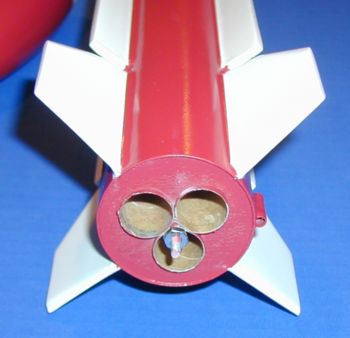 Next, the 3/32" laser-cut plywood centering rings are glued onto the motor tubes. Interestingly, the center "triangle" of the centering ring needed to be taken out. It is not interesting that it couldn't stay in there, it is interesting that it was there to begin with. The rings require just a touch of sanding to fit nicely.
Next, the 3/32" laser-cut plywood centering rings are glued onto the motor tubes. Interestingly, the center "triangle" of the centering ring needed to be taken out. It is not interesting that it couldn't stay in there, it is interesting that it was there to begin with. The rings require just a touch of sanding to fit nicely.
You are then instructed to drill a small hole through the upper centering ring and thread the Kevlar shock tether through it. It is then tied around all three motor tubes. Fillets of glue are placed in the appropriate places and then it is glued into the body tube.
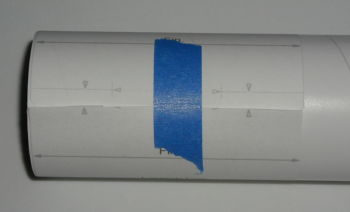 Next, the body tube is marked using the fin marking guide. My tube marking guide did not fit, however, after an e-mail to Thrustline I'm confident that future kits will not have this problem. I used an Estes Tube Marking Guide to mark my tube.
Next, the body tube is marked using the fin marking guide. My tube marking guide did not fit, however, after an e-mail to Thrustline I'm confident that future kits will not have this problem. I used an Estes Tube Marking Guide to mark my tube.
Next, the fins are cut out of the 1/8" balsa stock (4 of each type, which is considered to be obvious since the instructions don't tell you how many to cut out). One trend I have noticed and appreciate about Thrustline kits is that they do not skimp on balsa. I probably could have made 6-8 fins out of all the stock! Bravo!
The fins are sanded, airfoiled, and glued in place. Alignment of the upper with lower fins is important for looks and flight stability, so take your time on these.
I have never liked the Kevlar shock tether to hang out over the upper edge of the body tube at ejection. I'm always afraid that the line, strong line would be more likely to cause a zipper than a flat elastic shock cord. This is the first Thrustline kit that I have built that addressed this concern. They did so in a unique way as well. Even though the Kevlar line is very long, the instructions have you tie off a loop so that is stops just inside the body tube. Great job. To this, the 35" of 1/4" elastic shock cord is tied.
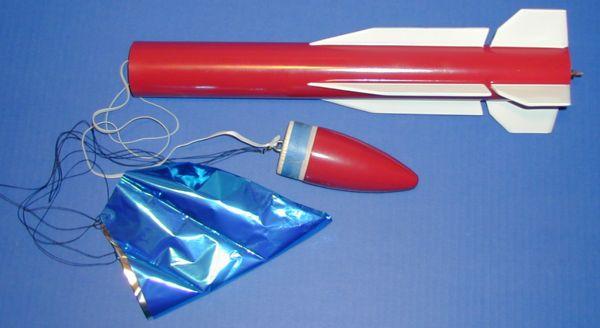
Next, the balsa nose cone gets our attention. Several holes are drilled into the nose cone, while leaving the center untouched for the installation of the eye-screw. The provided BBs are put in the holes and they are filled with glue. The instructions don't say what kind of glue, but I would strongly recommend epoxy. After this, the eye-screw is screwed/glued into the center of the nose cone.
Me, I like to handle this a bit different. I went ahead and drilled a center hole, filled it half way with BB's and then filled it to the top with epoxy. While the epoxy was still wet, I set the eye-screw in place. I think this is stronger than screwing the eye-screw into the balsa. May be a six to one, half-dozen to another though.
The nose cone tricked me. After I was ready, I test fit it into the body tube and it was too tight. I sanded it until it fit nicely. After a few days I came back to building this rocket and the nose cone fit too loosely? Huh? I'm thinking there was some humidity swell that had occurred when I fit test fit it. Regardless, it now has 1 wrap of tape to have it fit well.
Thrustline does give finishing guidance. They suggest sealing, sanding and using a tack cloth. The using a sandable primer, sanding in-between.
I soaked my fins with CA, then used by typical multiple coats of Plastic-Kote Primer. I finished it using Walmart $0.97 Red paint for the body and White paint for the fins. Thrustline had sent decals after the kit arrived, so I believe future kits will have water-slide decals. I did not use them.
Overall, for CONSTRUCTION I would rate this kit 4 ½ points. Fit of parts was good. Quality of parts was good. Instructions are good. My only complaint is that there was no motor retention system.
FLIGHT/RECOVERY:
Thrustline recommends (3) A8-3, B4-4 and C6-5 motors.
Thrustline indicates the rocket should weigh 4.5 ounces. My rocket weighed in at 5.6 ounces with an empty CG at 11" from the nose cone. I'm thinking some of that delta is in the nose weight, which according to the beta-test (see review below) needed adjusted. As well, I added the threaded stud and I have many coats of primer to try to get a smooth finish.
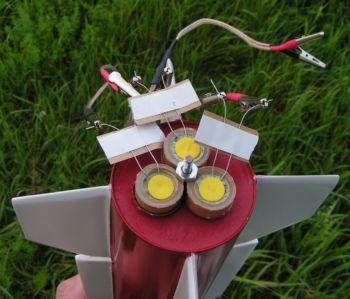 I decided to fly it for the first time on a three (3) A8-3's. I loaded the motors and then screwed a nut onto my threaded stud. I then loaded in 6-7 sheets of wadding, and put in the parachute. It was now ready to fly.
I decided to fly it for the first time on a three (3) A8-3's. I loaded the motors and then screwed a nut onto my threaded stud. I then loaded in 6-7 sheets of wadding, and put in the parachute. It was now ready to fly.
I used a D.B.M. Rocketry 3-Motor Cluster cable and set it up on the pad. The flight was a great first flight. It didn't go very high, my guess is about 75 feet (I have not simmed this one). The rocket descended faster than I suspected. I had initially thought the 18" parachute was too big for this rocket. I was prepared to reef it or cut a spill hole. No need.
The second flight was using three (3) B6-4's. Wow! I was super fast off the pad. It surprised me. It was still going up upon ejection, but was close enough. Pop, expand and descend. Recovered.
Third flight was on (3) B4-4's. Trying to slow it down a bit for a picture. This time it came off the pad and had a slight tail swirl on the way up. Most likely motor related since I did not see that on the B6's. It was not straight up either, which was probably due to wind or rod whip.
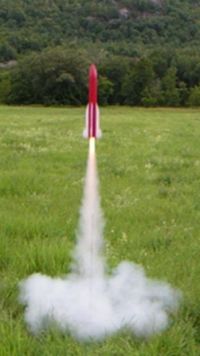 The rocket's diameter required 6-7 sheets of wadding and I also stuff 1/3rd of a piece into the top of each motor (above the cap). Doing this protected the parachute and there is no sign of burning/melting.
The rocket's diameter required 6-7 sheets of wadding and I also stuff 1/3rd of a piece into the top of each motor (above the cap). Doing this protected the parachute and there is no sign of burning/melting.
The bright metallic parachute has great visibility and adds to the kit. The Kevlar to elastic shock cord system is excellent.
For FLIGHT/RECOVERY, I would rate this rocket 5 points. If prepared properly and if you use a higher power launch controller (I use the Estes Command Controller 14.4V), then you will see a good number of flights on this rocket. The cluster makes it fun, too.
I give the rocket an OVERALL rating of 4 ½ points. It is not easy to find clusters in model rockets, but Thrustline's A-SLAM is one that I would recommend. On A8-3's, it would make a good demo rocket. On B6's or B4's it is a good "football" field flier. I'm looking forward to flying it on some C's and boy, oh, boy if I could get three Aerotech D21's!
Other Reviews
- Thrustline Aerospace A-SLAM By Allan Richardson
Brief: The Thrustline A-Slam was offered to me as a beta-test by Thrustline and to Put it simply, this is one great rocket. The A-Slam was delivered to me in sturdy packaging and none of the parts arrived damaged. When I saw the 2.1" body tube and the three 18mm motor tubes I knew this rocket would be a fun build. Construction: The kit included a precut 17" piece of ...
 |
 |
Flights
 |
 |